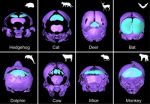(Press-News.org) The mammalian skull, including that of people, is composed of about 20 bones. Fish, reptile and bird skulls, however, have considerably more. After all, when mammals evolved from reptile-like vertebrates 320 million years ago, the skull's structure became simplified during its development and the number of skull bones decreased.
Some bones were lost in the lineage leading to mammals in the course of evolution, especially a number of skull roof bones. The skull's interparietal, which is one of the skull roof bones, particularly puzzled researchers: on the one hand, it seems to have survived, such as in humans, carnivores and ungulates (especially horses); on the other hand, it is not found in all mammals.
Together with a colleague from the University of Tübingen, Marcelo Sánchez, a professor of paleontology at the University of Zurich, and post-doctoral student Daisuke Koyabu have now detected the presence of the interparietal after all: Studying fossils and embryos of over 300 species of vertebrate, they were able to identify the bone in all of them. They used non-invasive micro-CT imaging to analyze rare embryos of different species from museum collections. "The interparietal was clearly discernible in specimens from the embryonic period as the skull bones were fused less strongly here," explains Sánchez. At the same time, he sees the fact that the bone is only clearly and easily discernible in the embryonic period as the reason why previous researchers failed to recognize it: "It would seem that many anatomists have overlooked the presence of the interparietal in numerous mammalian lineages as the bone becomes fused to other skull bones during growth and is unrecognizable in adult individuals."
Same skull bone in fish and humans
Another result that also refutes previous assumptions concerns the origin of the bone. As Koyabu reports: "Whilst it was previously assumed that the mammalian interparietal was composed of two elements, we discovered that it develops from four elements: a medial and a lateral pair."
The tabular bones of our reptile-like ancestors and fish correspond to the lateral interparietal bones, which were overlooked until now. According to the new results, however, they have survived in mammalian lineages after all.
The results also explain the mixed evolutionary tissue origin of the interparietal complex, which had been identified in mice but could not be confirmed by conventional anatomical tests: Genetic studies have revealed that the lateral bone pair develops from the mesoderm, but the medial pair from the neural crest cells.
This present study provides a conclusive explanation for the hitherto inexplicable mixed tissue origin of the interparietal complex: It stems from the evolutionary fusion of the os interparietale to the tabular bones in mammalian lineages.
The study also yields insights into us people, as Sánchez concludes: "The evidence of the continuation of fish bones in mammals provides new insights into the origins of our own anatomy." These anatomical discoveries were made possible thanks to a microtomographic imaging, the museum collections of rare animal embryos and the interdisciplinary collaboration between paleontology and embryology.
INFORMATION:
Literature:
Daisuke Koyabu, Wolfgang Maier, and Marcelo Sánchez-Villagra. Paleontological and developmental evidence resolve the homology and dual embryonic origin of a mammalian skull bone, the interparietal. Proceedings of the National Academy of Sciences PNAS. August 14, 2012. doi:10.1073/pnas.1208693109
Old skull bone rediscovered
2012-08-14
ELSE PRESS RELEASES FROM THIS DATE:
UC discoveries could help quiet the world's cities
2012-08-14
They're sleek. They're fast. They're powerful. And, they are deafening. Furthermore, those Top Gun military jets need to be up in the air in the wee hours – over land – to simulate their landings on aircraft carriers. But innovations out of the University of Cincinnati's Gas Dynamics and Propulsion Laboratory are showing promise in reducing the intense noise of these supersonic jets without impacting their power. It's research that can help neighborhoods slumber a little more soundly, keep their windows rattling a little less loudly and also protect the hearing of military ...
If it rolls or flies, UC research is working to keep it quiet
2012-08-14
University of Cincinnati research – from noise reduction in sophisticated military jets to quieter car rides – will be presented at INTER-NOISE 2012, the 41st International Congress and Exposition on Noise Control Engineering, to be held Aug. 19-22 in New York City. UC is among only a few universities with a specific focus on vehicle noise control.
The UC research to be presented at INTER-NOISE:
UC innovations to reduce the noise of the nation's most sophisticated military aircraft. Jeff Kastner, research assistant professor in the UC College of Engineering and Applied ...
UC research promises quiet cars -- even when hitting unexpected bumps in the road
2012-08-14
All noise is not necessarily equal – especially when it comes to sound minimization in automobiles.
For instance, automakers have long used sound-absorbing materials (passive control) in the design of cars in order to minimize engine noise and the "routine" noise of tires traveling on smooth pavement at a consistent speed. However, a means to minimize sudden, unexpected noises – like those from an encounter with potholes, bumps or other roadway pavement obstacles – has been more problematic.
A significant step in countering such unexpected roadway noises is the development ...
Marine research in the Brazilian rainforest
2012-08-14
Until recent decades the Atlantic Rainforest covered a large area of today's Brazil from Amazonas to present-day Argentina. In the 1970s, after years of deforestation, this rain forest was almost completely destroyed, mainly replaced by cattle pastures. This study reveals an unexpected aspect of deforestation. Thorsten Dittmar's team and colleagues from Brazil and the USA show that the common practice of slash and burn left huge amounts of charcoal in the soil. This charcoal is washed out by rainfalls and transported by rivers into the Atlantic Ocean. The soluble fraction ...
Girls with ADHD at risk for self-injury, suicide attempts as young adults, says new research
2012-08-14
WASHINGTON – Girls with attention deficit hyperactivity disorder are significantly more likely to attempt suicide or injure themselves as young adults than girls who do not have ADHD, according to research published by the American Psychological Association.
Young women diagnosed with attention deficit hyperactivity disorder as girls, particularly the type with early signs of impulsivity, were three to four times more likely to attempt suicide and two to three times more likely to report injuring themselves than comparable young women in a control group, according to ...
Hope for patients with HIV-associated cognitive impairment
2012-08-14
Current drug therapy for patients with HIV is unable to control the complete replication of the virus in the brain. The drugs therefore do not have any effect against the complications associated with neurocognitive impairment in patients with HIV. New research by Joseph Steiner and colleagues from Johns Hopkins University has discovered that a group of plant polyphenols known as catechins, which naturally occur in green tea and the seed of the cacao tree, may help in the prevention of these neurological complications. Their work is published online in Springer's Journal ...
Scientists uncover strategy able to dramatically reduce chemotherapy's side effects
2012-08-14
Researchers in Leuven (VIB/KU Leuven) have confirmed their hypothesis that normalizing blood vessels by blocking oxygen sensor PHD2 would make chemotherapy more effective. They also demonstrated for the first time that this strategy would reduce the harmful side effects of chemotherapy on healthy organs.
Limited success of chemotherapy
The effectiveness of chemotherapy is first and foremost limited by the difficulties of delivering the anticancer drugs to the actual tumor. Tumors are characterized by abnormally shaped blood vessels – they are irregular in shape, have ...
Nearly 1,000 earthquakes recorded in Arizona over 3 years
2012-08-14
TEMPE, Ariz. – Earthquakes are among the most destructive and common of geologic phenomena. Several million earthquakes are estimated to occur worldwide each year (the vast majority are too small to feel, but their motions can be measured by arrays of seismometers). Historically, most of Arizona has experienced low levels of recorded seismicity, with infrequent moderate and large earthquakes in the state. Comprehensive analyses of seismicity within Arizona have not been previously possible due to a lack of seismic stations in most regions, contributing to the perception ...
Launching a 'social networking war' against cancer
2012-08-14
Experts agree that, more than ever before, modern wars will be fought in the cyber zone, targeting an enemy's communications technology to cause untold damage. Now a Tel Aviv University researcher is suggesting that the same tactics should be employed in the battle against one of the body's deadliest enemies — cancer.
In an article published in Trends in Microbiology, Prof. Eshel Ben-Jacob of TAU's School of Physics and Astronomy and Prof. Herbert Levine of Rice University, long-time bacteria researchers, and Prof. Donald Coffey of Johns Hopkins University, a renowned ...
Studies seek better understanding and treatment of depression
2012-08-14
AUGUSTA, Ga. – Connecting the dots between two molecules whose levels are decreased in depression and increased by current antidepressants could yield new therapies, researchers say.
Serotonin is a neurotransmitter that enables brain cells to communicate and brain-derived neurotropic factor, or BDNF, is a brain-nourishing molecule that also aids connectivity. Popular antidepressants such as Prozac, developed to increase levels of serotonin, have recently been found to also increase BDNF levels, said Dr. Anilkumar Pillai, neuroscientist at the Medical College of Georgia ...





